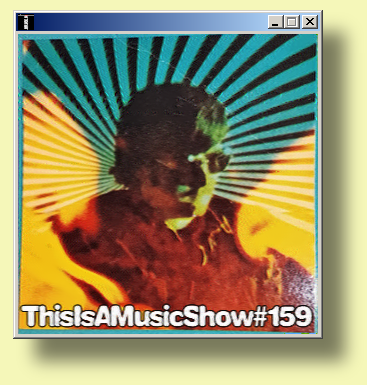http://www.rhci-online.net/radiogram/radiogram.htm

http://www.rhci-online.net/radiogram/radiogram.htm

RSID: <<2022-03-31T23:31Z MFSK-32 @ 9265000+1500>>
Welcome to program 250 of Shortwave Radiogram.
I'm Kim Andrew Elliott in Arlington, Virginia USA.
Here is the lineup for today's program, in MFSK modes as noted:
1:34 MFSK32: Program preview (now)
2:42 MFSK32: Solar Orbiter probe new image of Sun's corona*
7:33 MFSK64: First step towards genuine plastic recycling
11:24 MFSK64: This week's images*
28:23 MFSK32: Closing announcements
* with image(s)
Please send reception reports to radiogram@verizon.net
And visit http://swradiogram.net
We're on Twitter now: @SWRadiogram
From New Atlas:
Solar Orbiter probe snaps the sharpest ever image of the Sun's
corona
Nick Lavars
March 24, 2022
Since launching in February of 2020, the Solar Orbiter probe has
been zeroing in on the Sun with a suite of instruments designed
to unravel some of its secrets. Among those is an advanced
ultraviolet imager, which mission control has now used to capture
the highest-resolution image ever of the Sun's outer atmosphere.
The incredibly detailed new image was captured by the Extreme
Ultraviolet Imager aboard NASA and the ESA's Solar Orbiter, which
shoots at the wavelength required to image the Sun's outer
atmosphere, or corona, where temperatures sit at around one
million °C (1.8 million °F).
The spacecraft was around 75 million km (46 million miles) away
from the Sun on March 7 when it captured this sharp new view,
taking 25 individual images over the course of four hours to
create the final mosaic. This resulting image features more than
83 million pixels in a 9,148 x 9,112 pixel grid, which is a
resolution around 10 times that of a 4K TV.
At the same time, the probe's Spectral Imaging of the Coronal
Environment (SPICE) instrument was used to image the Sun in the
wavelength of ultraviolet light emitted by different atoms. This
enables it to peer beneath the corona and take the Sun's
temperature at a layer known as the chromosphere.
The purple depicts hydrogen gas at 10,000°C, blue depicts carbon
at 32,000°C, green depicts oxygen at 320,000°C, and yellow
depicts neon at 630,000°C. These kinds of insights will help
scientists understand how temperature rises through the
atmospheric layers of the Sun, which counterintuitively is much
higher at the corona than it is at the surface (around 5,000 °C).
Source: ESA
https://newatlas.com/space/solar-orbiter-probe-sharpest-image-sun-corona/
A close-up from Solar Orbiter's record-breaking 83 million pixel
image of the Sun ...
Sending Pic:207x135C;

Shortwave Radiogram now changes to MFSK64 ...
RSID: <<2022-03-31T23:37Z
MFSK-64 @
9265000+1500>>
This is Shortwave Radiogram in MFSK64
Please send your reception report to
radiogram@verizon.net
From Futurity.org:
Team takes key step toward truly recycling plastic
Researchers have successfully broken plastic into its
molecular building blocks and recovered over 90% of them.
Posted by Peter Rüegg
March 28th, 2022
It's a first step towards genuine plastic recycling.
The chemical industry has a long tradition of producing polymers.
This involves turning small molecular building blocks into long
chains of molecules that bond together. Polymers are the basis of
all kinds of everyday plastics, such as PET and polyurethane.
However, while the formation of polymers is well established and
well researched, scientists have given little attention to how
polymer chains are broken down (a process called
depolymerization) to recover their individual building blocks,
called monomers.
Breaking down polymers is a complex process. Whether a polymer
can be broken back down at all into its constituent parts depends
on which of the different polymer manufacturing processes created
it. In addition, the depolymerization processes used so far
require a lot of energy, which has made them too expensive. And,
recycled polymers are usually only used to make low-value
products.
Athina Anastasaki, professor of polymeric materials at ETH
Zurich, wants to change this. Her goal is producing polymers that
can be easily broken down into their building blocks so that they
can be fully recycled.
Anastasaki has taken a first step in this direction: A study by
her group appears in the Journal of the American Chemical
Society. In it, Anastasaki and her colleagues show that they can
break down certain polymers into their basic building
blocks—monomers—and recycle them for use in materials for further
applications.
The polymers broken down are polymethacrylates (e.g. Plexiglass)
that were produced using a specific polymerization technique
called reversible addition-fragmentation chain-transfer
polymerization, otherwise known as RAFT. This relatively new
method, which is now also attracting the interest of industry,
produces polymer chains of uniform length.
The researchers have succeeded in recovering up to 92% of the
building blocks of polymethacrylates without adding a catalyst
that would enable or accelerate the reaction.
"Our method could conceivably be developed even further to
involve the use of a catalyst. This could increase the amount
recovered even more," says Anastasaki.
The chemical group present at the end of a polymer chain is
crucial for the polymer's breakdown. By heating the polymer
solvent mixture to 120°C, the researchers created what are
referred to as "radicals" at the end of a polymethacrylate chain,
which triggered the depolymerization. Researchers at the
Australian National University in Canberra confirmed the results
mathematically.
According to Anastasaki, the building blocks recovered in this
way can produce the same polymer or a completely different
product—an insoluble hydrogel that can also be broken down into
its monomers. The newly created products are of similar quality
to the original ones. This is in contrast to previous products
made from recycled polymers.
But there is a catch: "Products made with RAFT polymerization are
more expensive than conventional polymers," says Anastasaki. To
address this drawback, she and her group are working to expand
the method for large-scale use, which will make it more
competitive and the resulting products cheaper. The researchers
also aim to increase the amount retrieved and to recover all the
building blocks of a polymer.
Anastasaki is also researching whether other polymers can be
depolymerized. She is particularly interested in polystyrene, a
widespread, low-cost plastic that has many everyday uses, such as
Styrofoam.
Even if this new method raises hopes of solving humankind's
plastic waste problem, Anastasaki dismisses the idea for the time
being. There is no quick fix to the problem. "It will take a lot
of time and research before the process is established in the
chemical industry," she says. Nor will the method get rid of
plastic waste: today's polymers cannot be broken down in this
way. Some new, suitable polymers have to come into circulation
before their building blocks can be recovered. But the method has
one advantage: its introduction and use require no new chemical
plants.
"We are only at the beginning of our research into
depolymerization. There are over 30,000 studies on developing new
polymerization strategies, with only a handful of them addressing
the subject of monomer recovery," says Anastasaki.
Source: ETH Zurich
https://www.futurity.org/depolymerization-polymers-2717042-2/
See also:
https://pubs.acs.org/doi/10.1021/jacs.2c00963#
This is Shortwave Radiogram in MFSK64
Please send your reception report to
radiogram@verizon.net
This week's images ...
Our propagation indicator is six circles in six colors.
https://bit.ly/3NDUaBi ...
Sending Pic:212x119C;

The moon rises behind the buildings of the banking district in
Frankfurt.
https://bit.ly/3uFqXxn ...
Sending Pic:142x201C;

Watching the Mediterranean sea in Barcelona.
https://bit.ly/3uFqXxn ...
Sending Pic:241x89C;

A stork nests at the LIPU Stork Center in Racconigi, Italy, on
March 24.
https://bit.ly/3Ds7unF ...
Sending Pic:300x200;

A tea plantation in Hezhou, Guangxi Zhuang Autonomous Region,
China, March 19.
https://bit.ly/3Ds7unF ...
Sending Pic:157x205C;

Lanterns at a temple in Seoul in preparation for the upcoming
birthday of Buddha.
https://bit.ly/3uMmb1f ...
Sending Pic:195x165C;

Raindrops on the shiny surface of a blue metal bin.
https://bbc.in/36Bc8UJ ...
Sending Pic:204x150C;

Eilean Donan Castle in Scotland lit up in the colours of the
Ukraine flag. https://bbc.in/3qTB1ld ...
Sending Pic:194x184C;

A black and white warbler at the Quintana Neotropical Bird
Sanctuary in South East Texas.
https://bit.ly/36Mm917 ...
Sending Pic:208x127C;

Our painting of the week is "Weasels Playing" (1911) by Franz
Marc. https://bit.ly/3DpXqf3 ...
Sending Pic:139x212C;

Shortwave Radiogram returns to MSFK32 ...
RSID: <<2022-03-312T23:58Z MFSK-32 @ 9265000+1500>>
This is Shortwave Radiogram in MFSK32 ...
Shortwave Radiogram is transmitted
by:
WRMI, Radio Miami International, wrmi.net
and
WINB Shortwave, winb.com
Please send reception reports to
radiogram@verizon.net
And visit http://swradiogram.net
Twitter:
@SWRadiogram or twitter.com/swradiogram
I'm Kim Elliott. Please join us for the next Shortwave
Radiogram.
|
Closing music SWRG#250: https://en.wikipedia.org/wiki/The_Kiffness
|
http://www.rhci-online.net/radiogram/radiogram.htm
|
QTH: |
D-06193 Petersberg (Germany/Germania) |
|
|
Ant.: |
Dipol for 40m-Band & Boomerang Antenna 11m-Band |
|
|
RX for RF: |
FRG-100B + IF-mixer & ICOM IC-R75 + IF-mixer |
|
|
Software IF: |
con STUDIO1 - Software italiano per SDR [S-AM-USB/LSB] + beta 11 Version 2.80 (August 21, 2018) - for scheduled IF-recording |
|
|
Software AF: |
Fldigi-4.0.18 + flmsg-4.0.7 images-fldigifiles on homedrive.lnk |
|
|
OS: |
German XP-SP3 with support for asian languages |
German W7 32bit + 64bit |
|
PC: |
MEDION Titanium 8008 (since 2003) [ P4 - 2,6 GHz] |
MSI-CR70-2MP345W7 (since2014) [i5 -P3560 ( 2 x 2,6GHz) ] |
http://wiki.radioreference.com/index.php/Decoding_the_SW_Radiogram_Broadcasts
https://www.qsl.net/ve7vv/Files/Digital%20Modes.pdf
RSID: <<2022-04-03T01:30Z
MFSK-64 @
5960000+1500>>
Jan Berry of Jan and Dean was born April 3, 1941.
He died in 2004.
Sending Pic:250x143;

Please report your decode to themightykbc@gmail.com
RSID: <<2022-04-03T01:48Z MFSK-64 @ 5960000+1500>>

RSID: <<2022-03-31T02:51Z MFSK-64 @ 5850000+1500>>
This Is A Music Show #159
31 March 2022
0200-0300UTC Thursday on 5850 kHz
via WRMI, Okeechobee USA
***ALSO***
TIAnExpressMS w/ Radio Northern Europe International
via Channel 292 in Germany, mainly on 6070 kHz.
Broadcast various dates/times/freqs. Check the schedule here:
https://www.channel292.de/
https://rnei.org/
----------------------------------------
PLAYLIST
Quincy Jones And His Orchestra - Rico Vacilon
-----
Deodato - Black Dog
Ragni Rado MacDermot - One Thousand Year Old Man
Loadstone - Time
-----
Wilbert Longmire - Give It Up Or Turnit Loose
Shirley Ellis - The Nitty Gritty
Ramones - Baby, I Love You
-----
Bo Hansson - Black Riders/Flight To The Ford
Bill Perkins Quintet - Groover Wailin'
-----
Jane Siberry - Mimi On The Beach
-----
THIS DATA w/ Bert Kaempfert - Main Theme From "A Man Could Get Killed"
-----
Marianne Faithfull - As Tears Go By
----------------------------------------
TIAMS Website:
https://thisisamusicshow.com
Go here for show archives + official shop!
-----
Please send reception reports/comments:
thisisamusicshow@gmail.com
Follow TIAMS on Twitter:
www.twitter.com/ThisIsAMusicSho/
------
Thanks for listening!
--YOUR HOST--
EOM
RSID: <<2022-03-31T02:53Z MFSK-64 @ 5850000+1500>>
Sending Pic:300x300Cp4;


RSID: <<2022-04-03T11:55Z MFSK-64 @ 6070000+1500>>
This Is An Express Music Show
April 2022
---------------------------------------
PLAYLIST
Bobby Blossom And The Montego Bay Street People - Persuader
------
Yatchs - In A Second
Loadstone - Time
The Dramatics - What You See Is What You Get
Bobby Hutcherson - A Night In Barcelona
Almont Reid - Sugar Pt.2
------
THIS DATA - Bert Kaempfert - Sweet And Gentle
------
The Royal Jokers - You Came Along
----------------------------------------
Please send reception reports/comments:
thisisamusicshow@gmail.com
Follow TIAMS on Twitter:
www.twitter.com/ThisIsAMusicSho/
**WEBSITE**
https://thisisamusicshow.com
------
Thanks for listening!
--YOUR HOST--
EOM
RSID: <<2022-04-03T11:27Z MFSK-64 @ 6070000+1500>>
|
- |
http://www.rhci-online.net/html/RNEI28-ch292.html
